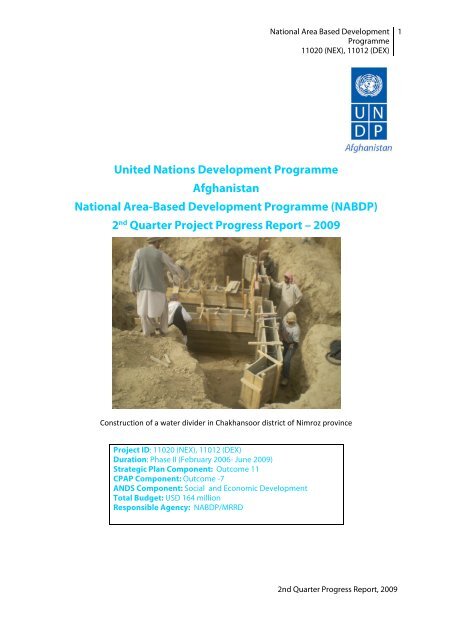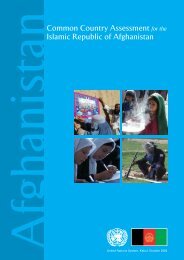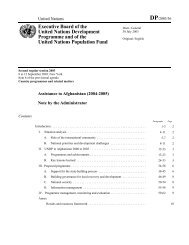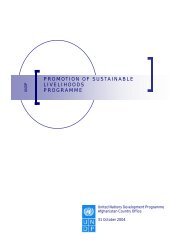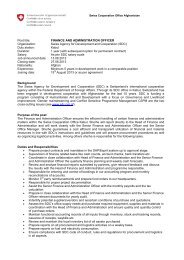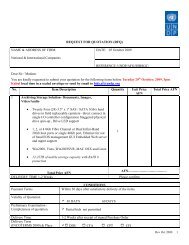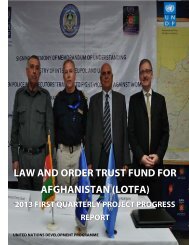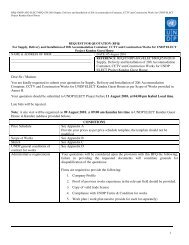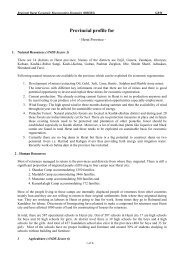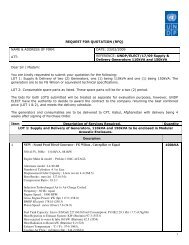(NABDP) 2nd Quarter Project Progress Report â 2009 - UNDP ...
(NABDP) 2nd Quarter Project Progress Report â 2009 - UNDP ...
(NABDP) 2nd Quarter Project Progress Report â 2009 - UNDP ...
You also want an ePaper? Increase the reach of your titles
YUMPU automatically turns print PDFs into web optimized ePapers that Google loves.
National Area Based Development<br />
Programme<br />
11020 (NEX), 11012 (DEX)<br />
1<br />
United Nations Development Programme<br />
Afghanistan<br />
National Area-Based Development Programme (<strong>NABDP</strong>)<br />
2 nd <strong>Quarter</strong> <strong>Project</strong> <strong>Progress</strong> <strong>Report</strong> – <strong>2009</strong><br />
Construction of a water divider in Chakhansoor district of Nimroz province<br />
<strong>Project</strong> ID: 11020 (NEX), 11012 (DEX)<br />
Duration: Phase II (February 2006- June <strong>2009</strong>)<br />
Strategic Plan Component: Outcome 11<br />
CPAP Component: Outcome -7<br />
ANDS Component: Social and Economic Development<br />
Total Budget: USD 164 million<br />
Responsible Agency: <strong>NABDP</strong>/MRRD<br />
<strong>2nd</strong> <strong>Quarter</strong> <strong>Progress</strong> <strong>Report</strong>, <strong>2009</strong>
National Area Based Development<br />
Programme<br />
11020 (NEX), 11012 (DEX)<br />
2<br />
<strong>NABDP</strong> DONORS<br />
Spain Canada Denmark United Kingdom<br />
Japan Norway Netherlands Belgium<br />
<strong>UNDP</strong><br />
<strong>2nd</strong> <strong>Quarter</strong> <strong>Progress</strong> <strong>Report</strong>, <strong>2009</strong>
National Area Based Development<br />
Programme<br />
11020 (NEX), 11012 (DEX)<br />
3<br />
Table of Contents<br />
Executive Summary .......................................................................................................................................................... 4<br />
Context…………………………………………………………………………………………………5<br />
Implementation <strong>Progress</strong> ............................................................................................................................................... 5<br />
Output 1. ............................................................................................................................................................................... 6<br />
Output 2 ................................................................................................................................................................................ 8<br />
Output 3 ................................................................................................................................................................................ 7<br />
Output 4:……………………………………………………………………………………………... 11<br />
Crosscutting Issues……...……………………………………..…………………………………… ...13<br />
Gender…….…………..…………………….…………………………………………………………13<br />
CapacityBuilding………...……………………………………….……………………………………14<br />
Challenges……………………………………………………………………..…………………..…..14<br />
Risks………… …….……………………………………………………………………………….…14<br />
Issues……………….…………………………………………………………………………………13<br />
Lessons Learned ............................................................................................................................................................... 14<br />
Future Plans ....................................................................................................................................................................... 15<br />
Financial Section .............................................................................................................................................................. 16<br />
Table 1. Funding Overview ..................................................................................................... 16<br />
Table 2: Expenditure Status (by activity) ................................................................................ 20<br />
Table 3. Expenditure Status (by donor) .................................................................................. 20<br />
Annexes ............................................................................................................................................................................... 24<br />
Annex I: Performance Tracking Matrix ................................................................................... 24<br />
Annex II: Risk Log ..................................................................................................................... 30<br />
Annex III: Issue Log .................................................................................................................. 32<br />
<strong>2nd</strong> <strong>Quarter</strong> <strong>Progress</strong> <strong>Report</strong>, <strong>2009</strong>
National Area Based Development<br />
Programme<br />
11020 (NEX), 11012 (DEX)<br />
4<br />
Executive Summary<br />
During the second quarter, <strong>NABDP</strong> has continued to make progress in line with the three goals of<br />
the programe, as laid out in the Phase II project document, while taking and increasingly<br />
sustainable and strategic approach. These goals include a) regional economic development, b)<br />
capacity development, and c) immediate recovery projects. An overview of the progress made<br />
during this quarter is as follows:<br />
Community Empowerment: In this quarter, 28 district development assemblies (DDAs) have<br />
been established and 28 district development plans (DDPs) were formulated. The Disaster<br />
Management unit (DM) conducted awareness workshops for sectoral departments in Nangarhar,<br />
Badakhshan and Ghor provinces. Capacity-building training has been carried out in Balkh,<br />
Kandahar, Ghor, and Kunar provinces.<br />
Economic Regeneration: Four facilitating partners are working to support the development of<br />
five SMEs in Balkh, Bamyan and Herat provinces. Business development officers are now working<br />
in all seven border provinces projects. Twenty-four newly-approved SMEs are expected to be<br />
rolled-out in the next quarter as part of the Border Provinces SME support project. In Phase III,<br />
economic regeneration (ER) projects will be phased out of <strong>NABDP</strong> and subsumed within the<br />
Afghanistan Rural Enterprise Development Programme (AREDP) of MRRD, particularly into its topdown<br />
approach for SMEs development.<br />
Institutional Development: The Institutional Development (ID) unit facilitated six DDA ‘Grant-in-<br />
Aid’ activities in Kunar, Nangarhar, Kandahar, Badakhshan and Balkh provinces. A revision of the ID<br />
budget has been made to include the expansion of ‘Grant-in-Aid’ to 52 districts of 11 provinces.<br />
For Phase III, the ID unit will be dissolved and replaced by the new Policy and Planning Unit (PPU).<br />
Implementation Unit: In this quarter, 359 projects have been contracted, and another 56 have<br />
been committed and are either under design or in the procurement phase. Seventeen projects<br />
have been canceled for a variety of reasons, including social conflicts and community disputes,<br />
irresolvable issues with the contracted companies, shortage of available funds, and lack of security<br />
in some areas.<br />
Context<br />
The National Area Based Development Programme (<strong>NABDP</strong>), a joint project of the United Nations<br />
Development Programme (<strong>UNDP</strong>) and the Ministry of Rural Rehabilitation and Development<br />
(MRRD), aims to contribute to the sustainable reduction of poverty and the improvement of<br />
livelihoods in rural Afghanistan by empowering communities to articulate and address their needs<br />
and priorities. <strong>NABDP</strong> also aims to help enable the Government of Afghanistan (GoA) to support<br />
community-based rural rehabilitation and development in an integrated, people-focused,<br />
inclusive and participatory manner.<br />
<strong>NABDP</strong>’s second quarter activities have been in line with the outcomes and goals of the United<br />
Nations Development Assistance Framework (UNDAF), the Afghanistan National Development<br />
Strategy (ANDS), and the Country Program Action Plan (CPAP). Those outcomes are as follows:<br />
• UNDAF Outcome 2: By 2008, opportunities, skills, land and infrastructure that allow for active<br />
participation in a strengthened formal economy and private sector are improved, particularly<br />
for poor and vulnerable groups.<br />
<strong>2nd</strong> <strong>Quarter</strong> <strong>Progress</strong> <strong>Report</strong>, <strong>2009</strong>
National Area Based Development<br />
Programme<br />
11020 (NEX), 11012 (DEX)<br />
5<br />
• CPAP Output 7: Vulnerable groups (ex- combatants, returnees, disabled, women) empowered<br />
through improved access to social and economic opportunities (local poverty initiatives,<br />
private sector development, alternative livelihoods, and empowerment of women).<br />
• CPAP Indicator 7.1: Number of people receiving employment opportunities through skills<br />
training, agriculture support and small business starters support.<br />
• <strong>NABDP</strong> has also made major progress in the second quarter toward the achievement of ANDS<br />
Compact Benchmark 6.2 and 6.3 though its rural development projects. These benchmarks<br />
encourage 1) comprehensive rural development through community empowerment and<br />
local governance, which <strong>NABDP</strong> supports through the establishment of community councils<br />
and district assemblies; and 2) the implementation of programs to achieve a reduction in the<br />
amount of land under drug cultivation by the strengthening of licit livelihoods and other<br />
counter-narcotics measures, which <strong>NABDP</strong> supports through its economic regeneration<br />
programmes with the aid of the Counter Narcotics Trust Fund (CNTF).<br />
These above outcomes and outputs are specifically addressed through the continued emphasis<br />
on labor-intensive, economically-productive infrastructure projects, which are prioritized through<br />
the District Development Plans (DDPs) produced by DDAs and through small business planning<br />
and grant support to small and medium enterprises (SMEs).<br />
Implementation <strong>Progress</strong><br />
Output1: Comprehensive rural development plans, based on<br />
participatory community.<br />
(1.1) Development processes and economic regeneration assessments and<br />
strategies.<br />
Through a participatory process facilitated by Community Empowerment (CE), a total of 28 DDAs<br />
and 28 DDPs have been established in the second quarter of <strong>2009</strong>. This brings the total number to<br />
355, covering 88.5 percent of the country.<br />
Following their formation, DDAs undergo capacity building trainings in the areas of local<br />
governance, conflict resolution, gender equity, participatory project implementation and financial<br />
management. This quarter, training has been carried out in 13 districts of Kandahar, Ghor, Kunar<br />
and Balkh provinces. The new Disaster Management (DM) unit has also prepared a training<br />
module for DDAs and in this quarter has conducted training in eight districts of Nangarhar, five<br />
districts of Badakhshan, and two districts of Ghor. In a recent assessment undertaken by the<br />
Institutional Development (ID) component, DDA members revealed that the trainings helped<br />
them improve their knowledge of development-related issues and influenced development actors<br />
at the district level as well as helped them acquire skills for managing development activities.<br />
The establishment and capacity building of these local institutions constitutes the formalization of<br />
a mechanism for collective action in all districts of Afghanistan. Communities are empowered to<br />
articulate their needs and priorities through the formulation of development plans that reflect the<br />
community’s medium- and long-term development priorities. In the <strong>2nd</strong> quarter, 55 District<br />
Development Plans (DDPs) in Nangarhar, Kunar, Takhar, and Maidan Wardak provinces have been<br />
verified by the Community Empowerment office at <strong>NABDP</strong> and uploaded on to the <strong>NABDP</strong><br />
website, accessible for all development actors and the general public. DDPs of Kunar are in various<br />
<strong>2nd</strong> <strong>Quarter</strong> <strong>Progress</strong> <strong>Report</strong>, <strong>2009</strong>
National Area Based Development<br />
Programme<br />
11020 (NEX), 11012 (DEX)<br />
6<br />
stages of processing. All DDPs published are fully aligned to the DDA/DDP Operational Guidelines<br />
set by the <strong>NABDP</strong> team.<br />
The DDA establishment process also involves a dimension of institutional recognition and<br />
legitimacy as the DDAs receive a registration certificate in tandem with the handing over of<br />
relevant documentation to the Provincial Rural Rehabilitation Departments (PRRDs). In this<br />
quarter, 73 DDAs have been registered and issued certificates in seven provinces.<br />
In the case of those DDAs in ‘at-risk’ communities receiving a grant for community disaster<br />
preparedness from the Bureau for Crisis Prevention and Recovery (BCPR), a training module has<br />
been prepared. This quarter, these awareness workshops have been conducted in 15 districts,<br />
including five in Badakhshan, eight in Nangarhar, and two in Ghor. The participants included<br />
sectoral departments, PRRD social mobilizers, national and international NGO staff and DDA<br />
members. In addition, a District Disaster Management Committee was established within the<br />
DDAs in the districts of five provinces this quarter. These communities are now better able to<br />
mitigate and deal with major risks, e.g. droughts, floods or earthquakes.<br />
(1.2) Public investment priorities identified and implemented for SME<br />
improvement / development.<br />
In partnership with MRRD’s Afghanistan Rural Enterprise Development Program (AREDP), <strong>NABDP</strong>’s<br />
Economic Regeneration (ER) unit continued in the 2 nd quarter to contribute to the economic<br />
growth of the private sector. For Phase III, ER is leaving <strong>NABDP</strong> to become part of AREDP. To date,<br />
there has been no Ministry program solely dedicated to economic regeneration; thus, these types<br />
of projects have fallen under the responsibility of either NSP or <strong>NABDP</strong>’s ER unit, even though<br />
<strong>NABDP</strong>’s core business is local governance, renewable energy, and infrastructure, not economic<br />
regeneration. The core business area of AREDP, which is a project jointly designed by MRRD, the<br />
World Bank, and the UK’s Department for International Development (DFID), is economic<br />
development, income generation and enterprise development, thus making it the most<br />
appropriate program for ER to phase into. The decision to phase out ER into AREDP is in<br />
accordance with a decision made at the management level of <strong>NABDP</strong> during the design of Phase<br />
III that all MRRD programs are to refocus on their respective core business areas.<br />
This phase out process is underway and is expected to be finalized with the anticipated World<br />
Bank approval of AREDP later this year.<br />
Based on previously-developed business plans, four facilitating partners are working on five<br />
contracts for rural SME development support: ‘Hand in Hand’ for one melon and one almond<br />
enterprise in Balkh, Sanayee Development Organisation for carpet-making in Balkh and a saffron<br />
enterprise in Herat, Cooperation Centre for Afghanistan for a potato storage enterprise in Bamyan,<br />
and Ghazni, Rural Support Program for a carpet value chain development project in Bamyan.<br />
Initial progress reports have been submitted, and further instalment grants have been distributed.<br />
The timeline for the above-mentioned SMEs has been extended for three months, as the work has<br />
not been completed within the expected timeframe owing to delays in project start-up.<br />
Additionally, under the Border Provinces SME Support Program, twenty-four other SMEs have<br />
been verified, approved, and will be rolled out within the next quarter. One is currently being<br />
piloted in Nangarhar and will be expanded into other regions based on positive results.<br />
<strong>2nd</strong> <strong>Quarter</strong> <strong>Progress</strong> <strong>Report</strong>, <strong>2009</strong>
National Area Based Development<br />
Programme<br />
11020 (NEX), 11012 (DEX)<br />
7<br />
In the first quarter, selected entrepreneurs in Bamyan and Balkh received trainings in business<br />
management, finance and operations. During the second quarter, more of these trainings were<br />
planned and will be administered to other entrepreneurs, local farmers, and traders who have<br />
contracts with the above mentioned enterprises through the facilitating partners over the next<br />
three months. These trainings enable entrepreneurs to function according to standards with<br />
enhanced management skills.<br />
In June, the ER unit renewed the contracts of 13 business development specialists working for the<br />
seven Border <strong>Project</strong> provinces, extending their work time until the proposed project end date of<br />
December <strong>2009</strong>. The specialists continue to work with SMEs on business planning, advice, training<br />
and provision of a matching grant for investment.<br />
Output 2: Rural development policies developed and adopted by the<br />
Government and other relevant stakeholders, providing frameworks for<br />
viable interventions for economic regeneration, poverty reduction and<br />
improving livelihoods.<br />
(2.1) Policy feedback and ongoing preparation of national level AREDP program<br />
AREDP is being jointly designed by MRRD, World Bank, and DFID. Because the World Bank funding<br />
cycle has several steps, approval can take anywhere between 6 months and 3 years. AREDP is<br />
currently in the pre-appraisal mission. A final appraisal mission by the World Bank is forthcoming<br />
in August, and program approval by the World Bank is anticipated in October <strong>2009</strong>. Soon after, the<br />
program is anticipated to become eligible for multi-donor funding through the Afghanistan<br />
Reconstruction Trust Fund (ARTF) mechanism and from bilateral donors with the support of<br />
<strong>UNDP</strong>/<strong>NABDP</strong>. AREDP is anticipated to be operating in eight provinces across the country within<br />
two months after its approval.<br />
Economic regeneration unit is collaborating with AREDP to support Small and Medium Enterprises<br />
(SMEs) as part of the Border Provinces project, which entails using Business Development<br />
Specialists (BDS) to identify and support promising SME business plans through matching grants<br />
and technical input and trainings, as described in the above section. The lessons learnt from these<br />
pilot projects will provide useful inputs in developing future strategies for AREDP’s support to<br />
SMEs in Afghanistan.<br />
(2.2) Support to Afghan Government energy policy development.<br />
The Energy for Rural Development in Afghanistan (ERDA) <strong>Project</strong> has developed a micro-hydro<br />
policy for Afghanistan in consultation with the National Solidarity Program (NSP) and Rural Energy<br />
and Enterprise Development (REED). This micro-hydro policy is complete and is expected to be<br />
approved in the next several months. The micro-hydro policy is part of a larger, more<br />
comprehensive rural energy policy. <strong>NABDP</strong>/ERDA hired a rural energy policy expert in April to<br />
prepare this comprehensive rural energy policy for Afghanistan. A draft of this policy was<br />
completed on July 20 and will be discussed within MRRD and then presented to the Inter-<br />
Ministerial Commission on Energy (ICE) Sub-committee for Renewable Energy and Rural<br />
Electrification for comments from organizations involved in rural energy promotion in the country.<br />
<strong>2nd</strong> <strong>Quarter</strong> <strong>Progress</strong> <strong>Report</strong>, <strong>2009</strong>
National Area Based Development<br />
Programme<br />
11020 (NEX), 11012 (DEX)<br />
8<br />
The sub-committee will present the policy document to the ICE for approval and promulgation as<br />
the Afghanistan Rural Energy Policy.<br />
Output 3: Strengthened management and implementation capacity of<br />
MRRD and relevant partner institutions to address rural development<br />
and economic regeneration needs and priorities.<br />
(3.1) Improved MRRD capacity to implement rural energy projects<br />
The Energy for Rural Development in Afghanistan (ERDA) has been actively interacting with the<br />
Inter-Ministerial Commission on Energy (ICE), to discuss, coordinate, and plan renewable energy<br />
activities in Afghanistan. This component offered to deliver capacity building trainings to Rural<br />
Energy and Enterprise Development (REED), which are ongoing. ERDA works closely with this<br />
department and shares strategies, office space and coordinates activities. Currently, ERDA assists<br />
REED in assessing the performance of existing micro-hydro projects of MRRD. ERDA and REED<br />
technicians are assessing the status of micro-hydropower projects installed with NSP’s support in<br />
Panjshir and Bamyan provinces. The expected long-term result is for REED to independently<br />
manage rural energy activities as <strong>NABDP</strong>-ERDA phases out.<br />
During the second quarter, ERDA has been supporting MRRD to implement 300 kW Farkhar Mini<br />
Hydropower <strong>Project</strong> in Takhar Province.<br />
(3.2) CARD mechanism developed on district level through DDAs and an interactive<br />
delivery mechanism designed based on the assessments carried out on district and<br />
provincial level.<br />
In April, the final draft of the Comprehensive Agricultural and Rural Development (CARD)<br />
mechanism was approved. The Inter-Ministerial Committee (ICM) convened for the first ICM<br />
meeting in April to discuss and adopt terms of reference and to formalise the mobilisation plan for<br />
the CARD mechanism. Present at the ICM meeting were ministers from the Ministry of Counter<br />
Narcotics (MCN), the Ministry of Finance (MoF), the Ministry of Agriculture, Irrigation, and Livestock<br />
(MAIL), and the MRRD. In addition to establishing an interim financing plan, a communications<br />
plan, and an operations manual this quarter, there was an introductory mission trip to Nangarhar<br />
in April to introduce CARD and engage with the Governor and his team plus other stakeholders<br />
and development actors. Currently, Human Resources (HR) is in the process of recruiting and hiring<br />
a national CARD team.<br />
(3.3) The Grant-in-Aid programme piloted in Kandahar, Nangarhar, and Kunar.<br />
During the second quarter, the Institutional Development unit has been at the forefront of efforts<br />
to implement the DDA Grant-in-Aid scheme, which provides funding directly to DDAs to help<br />
them build their capacity. The ID unit is currently facilitating six DDA Grant-in-Aid activities in<br />
Kunar, Nangarhar, Kandahar, Badakhshan, Balkh, and Paktia provinces. In addition this quarter, the<br />
scheme has been started up in Argo district of Badakhshan province and Balkh district of Balkh<br />
province, and approved in Daman district of Kandahar. A revision of the ID budget has been made<br />
to include the expansion of ‘Grant-in-Aid’ to 52 districts of 11 provinces. Refer to the table below<br />
for a complete listing of districts receiving ‘Grant-in-Aid’:<br />
<strong>2nd</strong> <strong>Quarter</strong> <strong>Progress</strong> <strong>Report</strong>, <strong>2009</strong>
National Area Based Development<br />
Programme<br />
11020 (NEX), 11012 (DEX)<br />
9<br />
List of Districts for Grant in Aid Scheme<br />
S.No Province District<br />
1<br />
Achin<br />
2 Lalpor<br />
3 Dor baba<br />
4 Dehbala<br />
5 Spinghar<br />
6 Nangarhar<br />
Surkhrood<br />
7 Kot<br />
8 Dara e Noor<br />
9 Khaiwa<br />
10 Batikot<br />
11 Mohmand Dara<br />
12 Kandahar Daman<br />
13<br />
Sarkano<br />
14 Asad Abad<br />
15 Norgal<br />
16 Kunar<br />
Shegal<br />
17 Narang<br />
18 Asmar<br />
19 Chawki<br />
20<br />
Dand e Patan<br />
21 Jaji Aryoub<br />
22 Paktia<br />
Syed Karam<br />
23 Lija Mangal<br />
24 Chamkani<br />
<strong>2nd</strong> <strong>Quarter</strong> <strong>Progress</strong> <strong>Report</strong>, <strong>2009</strong>
National Area Based Development<br />
Programme<br />
11020 (NEX), 11012 (DEX)<br />
10<br />
(3.4) MRRD capacity building.<br />
Over the past two quarters, <strong>NABDP</strong>’s ID unit has provided technical assistance to the Community-<br />
Led Development Department (CLDD) and the Afghanistan Institute for Rural Development<br />
Department (AIRD). During the second quarter, the Institutional Development unit, in close<br />
consultation with relevant MRRD department heads and officials, prepared a draft of a new Terms<br />
of Reference (TOR) for CLDD. The objectives of CLLD have been revised in this new Terms of<br />
Reference. The role of the CLDD has been clarified as the supporting institution to local entities.<br />
<strong>NABDP</strong> continues to support the Rural Infrastructure and Technical Service (RITS) and PRRDs<br />
through its Technical Support Unit (TSU). The task of the TS U is to provide survey and design<br />
support to PRRDs, which often do not have an adequate level of staffing and technical capabilities<br />
to implement projects independently. During this quarter, a total of 29 projects have been<br />
surveyed and plotted by the TSU teams. The team of engineers recruited in the Kandahar regional<br />
TSU last quarter attended an irrigation workshop in Kabul during the second quarter. The TSUs<br />
across the provinces, located in Kabul, Mazar-i-Sharif, Jalalabad, Kunduz, Paktia and Kandahar,<br />
continue to closely monitor progress on <strong>NABDP</strong> projects.<br />
Output 4: High-quality and sustainable community-led rural<br />
development and economic regeneration investments that reduce<br />
poverty and improve livelihoods.<br />
(4.1) Preparation and implementation of rural infrastructure projects.<br />
In this quarter, 174 projects have been contracted, and another 56 have been committed and are<br />
either under design or in the procurement phase. Of that number, 17 infrastructure projects have<br />
been contracted in Ghazni, Nangarhar, Kunar, and Badakashan provinces, with three projects<br />
under procurement under the Japan-funded border provinces stabilization project. Sixty projects<br />
have been contracted and are underway through the Counternarcotics Trust Fund (CNTF) Labour-<br />
Based Rural Development (LBRD) project, which works in 10 provinces with the objective of<br />
reduced poppy growth. In addition, 97 regular infrastructure projects, exclusive of the above<br />
programmes, have been contracted in this quarter. Seventeen projects have been canceled for a<br />
variety of reasons, including social conflicts and community disputes, irresolvable issues with the<br />
contracted companies, shortage of available funds, and lack of security in some areas.<br />
Most CNTF efforts are devoted to simple water projects that communities can implement on their<br />
own as much as possible. This is done to improve security while improving water access for<br />
irrigation. <strong>Project</strong>s contracted in the second quarter of <strong>2009</strong> will provide 1 million working days in<br />
insecure areas. DDAs in Kandahar have reported that this year, very few people traveled to<br />
Helmand to work on poppy fields.<br />
As a part of <strong>NABDP</strong>’s stabilization efforts, the Disarming of Illegal Armed Groups (DIAG) program,<br />
regularly consults with the overall DIAG Joint Secretariat. It also cooperates with Afghanistan New<br />
Beginnings Programme (ANBP) to provide development projects in districts which have disarmed,<br />
and has provided assistance to the Ministry of Interior (MoI) in setting up an in-house DIAG unit.<br />
Up to this quarter, 13 DIAG projects have been completed, 27 are under construction, and 5 are in<br />
the design or survey phase.<br />
<strong>2nd</strong> <strong>Quarter</strong> <strong>Progress</strong> <strong>Report</strong>, <strong>2009</strong>
National Area Based Development<br />
Programme<br />
11020 (NEX), 11012 (DEX)<br />
11<br />
<strong>Progress</strong> has been made this quarter in the Integrated Alternative Livelihoods Program (IALP) in<br />
Kandahar, funded by the Canadian International Development Agency (CIDA). The nine-month<br />
work plan for IALP’s second phase, with a budget estimation of US$ 2.84 million, was submitted to<br />
headquarters in Kabul. Some main components of the work plan are as follows: the recruitment of<br />
a IALP-2K team by mid July <strong>2009</strong>; to conduct the Baseline Livelihoods Survey (BLS), interviewing<br />
1,600 individuals in four districts of Kandahar, and to design and implement livelihoods projects<br />
based on the BLS results; to provide capacity building to the district development assemblies<br />
(DDAs),the Department of Agriculture, Irrigation, and Livestock (DAIL), and the Provincial Rural<br />
Rehabilitation and Development department (PRRD); as well as the construction of the Kandahar<br />
Regional Agriculture and Rural Development Institute (KRARDI). In co-ordination with DAIL, IALP-<br />
2K managed to secure 20 jeribs of land at Tarnak farm for construction of KRARDI. Also at the<br />
operational level, the design for the KRARDI pipeline was finalized at the headquarters level in<br />
Kabul. At the administrative level, a deputy project manager was hired in April. The project<br />
manager resigned in June.<br />
(4.2) Monitoring, reporting and quality control activities.<br />
The activities of the Implementation Unit (IU) are supported and facilitated by the Quality Control<br />
(QC) unit, which has prepared design guidelines, technical manuals, and specifications for a variety<br />
of projects to assure and assess the quality implementation of projects. During the second quarter,<br />
the QC unit reviewed and approved numerous projects throughout the provinces, including two<br />
gravel road projects in Herat province, eight irrigation projects in Kandahar, and four irrigation<br />
projects in Nangarhar. Furthermore, the QC unit prepared survey forms for <strong>NABDP</strong> regional offices<br />
and distributed these forms.<br />
During the first quarter, <strong>NABDP</strong>’s Monitoring and Result-based <strong>Report</strong>ing unit (MRRU) developed<br />
and finalized a result-based monitoring manual. During this quarter, the manual was handed over<br />
to the Community Empowerment unit and will be shared with and taught to the DDAs to enhance<br />
the monitoring function through the CE unit. Next week, the manual will be piloted in Helmand<br />
province. From January to July <strong>2009</strong>, the field engineers visited 164 different projects for<br />
monitoring missions. Furthermore this quarter, MRRU has proposed a reporting flow structure<br />
based on the needs of <strong>NABDP</strong>. This has been shared with the unit heads and the regional<br />
managers.<br />
(4.3) Preparation and implementation of 8 MHP and 100 biogas projects.<br />
This past quarter, ERDA identified more than 50 potential sites for micro-hydropower projects and<br />
conducted detailed studies of 32 sites. The scale of these plants ranges between 15 and 60<br />
kilowatts. Detailed project reports of 12 sites have been prepared and construction work is<br />
underway in seven sites in Bamyan and Badkhshan . Furthermore, an 18 kW Zarshang micro-hydro<br />
plant in Bamyan was recently tested and the community is extending the distribution lines from<br />
the powerhouse to the settlements. In addition, ERDA is providing technical assistance in the<br />
construction of a 20 M 3 biogas plants in Charasiab, Kabul. ERD is supporting community members<br />
in the Jalalabad district of Nangarhar to install 10 biogas plants.<br />
(4.4) SMEs in Border Provinces improved/ established<br />
Under the Border Provinces SME Support Program, 13 Business Development Services Officers<br />
have carried out a situation analysis of business opportunities in the border provinces. ER has<br />
<strong>2nd</strong> <strong>Quarter</strong> <strong>Progress</strong> <strong>Report</strong>, <strong>2009</strong>
National Area Based Development<br />
Programme<br />
11020 (NEX), 11012 (DEX)<br />
12<br />
received 53 grant applications from the seven border provinces. After ground verification of all<br />
submitted applications, 36 applications have been approved, and 16 declined by the Grant Review<br />
Committee. Letters of offer have been sent out to the qualified SMEs. Upon acceptance of the<br />
offers, the practical work of utilizing the approved grants for the SMEs will begin.<br />
Crosscutting Issues<br />
Gender<br />
All DDAs established by the Community Empowerment unit in the second quarter have been<br />
mixed or include a women’s group or advisory committee, with an average of 14 women members<br />
each. In total, women comprise 2,829 (28%) of the total 10,050 DDA members. Trainings were also<br />
conducted for established DDAs. Gender equity trainings as part of the requisite 14-day trainings<br />
for the DDAs were provided to a total of 13 DDAs this quarter (347 participants, 94 of them<br />
female). Training sessions at the community intra-agency level to promote gender awareness have<br />
been carried out, and more are planned for Phase III.<br />
The Ministry of Women’s Affairs (MoWA), along with PRRD and <strong>NABDP</strong> regional offices, have<br />
discussed coordinating activities based on the memo of coordination between MRRD and MoWA<br />
which was completed on March 8, <strong>2009</strong>.<br />
Field visits to Mazar, Herat, and Jalalabad provinces took place during the second quarter with the<br />
aim to identify the existing challenges pertaining to gender-related issues. Some new DDAs were<br />
established and some reshuffled, and the gender advisor was there to observe how women are<br />
included in the process of DDA and DDP establishment. Separate meetings were conducted with<br />
the women to make them aware of what the process is for and the importance of their role in the<br />
DDA. In two districts of Jalalabad, gender focal points were assigned for DDAs for further<br />
coordination of activities among the DDA and the Department of Women’s Affairs. Gender focal<br />
points at the regional level were also identified in order to help mainstream gender at regional<br />
level.<br />
At the headquarters level, efforts have been undertaken during the second quarter to<br />
institutionalize gender awareness by drafting a comprehensive work plan and through<br />
coordination among the different directorates and programs of MRRD. Trainings conducted<br />
during the second quarter included a workshop on gender and Islam for <strong>NABDP</strong> staff in the Kabul<br />
office. Orientation sessions on gender-sensitive indicators and gender basics have been conducted<br />
for the provincial community mobilisers.<br />
<strong>NABDP</strong>’s gender strategy paper, which shifts the gender mainstreaming approach of <strong>NABDP</strong>, has<br />
been developed for implementation in Phase III.<br />
Capacity Building<br />
<strong>NABDP</strong> is increasingly focusing its capacity-building efforts at the district level. The Institutional<br />
Development and Community Empowerment units are continuing to cooperate on a programme<br />
of capacity building for DDAs, which will be a major feature of the upcoming Phase III of <strong>NABDP</strong>.<br />
Training has been completed in various districts of eight provinces and assessments of how DDAs<br />
take part in development activities have been completed in Kunar, Badakhshan, Mazar and<br />
Nangarhar. The implementation of the Grant-in-Aid scheme, which empowers DDAs to build their<br />
<strong>2nd</strong> <strong>Quarter</strong> <strong>Progress</strong> <strong>Report</strong>, <strong>2009</strong>
National Area Based Development<br />
Programme<br />
11020 (NEX), 11012 (DEX)<br />
13<br />
own physical and institutional capabilities, will be piloted in Nangarhar and Kunar in the next<br />
quarter.<br />
Challenges<br />
Risks<br />
Insecurity: The Implementation Unit consistently reported insecurity to be the most serious<br />
obstacle during the second quarter. During the second quarter, work on two projects in Zhari,<br />
Kandahar had been severely delayed as they were nearing completion. The head of the<br />
construction company who was implementing the project in this district was kidnapped by<br />
insurgents. <strong>Project</strong> operations were also interrupted in Farah province due to security concerns.<br />
Also, as two site supervisors travelled to monitor a canal project in Sarkano district of Kunar<br />
province, a remote control bomb exploded on the road, killing a national army soldier. These<br />
security incidents occurred in addition a suicide attack at the provincial council in Kandahar.<br />
In response to such security situations, MRRD relies heavily on the DDAs to implement the<br />
projects and contract directly with communities as often as possible to reduce the likelihood of<br />
security problems and to create local employment opportunities, though the security situation<br />
consistently leads to other problems such as delays or cancelations.<br />
Seasonal Risks: During the second quarter, flooding has been the prime issue, leading to the<br />
delay of some projects. The construction of the Sholgara Bridge in Balkh province was stopped<br />
this quarter due to the flooding of the Sholgara River. The flood destroyed the middle pillar of the<br />
bridge. Furthermore, the construction of Chimtal Bridge in Balkh province was stopped due to<br />
flooding. Heavy flooding also affected projects in Samangan, Badakhshan, and Jawzjan, destroying<br />
progress on these projects, and delaying the progress.<br />
Social Conflicts: Since <strong>NABDP</strong> has a participatory approach to identifying needs and priorities,<br />
social conflicts within communities often arise on project selection. There are two projects still<br />
experiencing social conflicts at the community level this quarter. For a school in Nahoor district of<br />
Ghazni, the community has not been able to decide on where to build the school, which has<br />
delayed the implementation of this project. The second conflict concerns a school project in Argo<br />
district of Badakhshan, which is 70 percent complete but was stopped because the contractor is no<br />
longer able to do the work. These conflicts were initially reported during the first quarter and have<br />
not yet been resolved. The regional staff has not been able to resolve these conflicts; thus, the<br />
provincial team was tasked by <strong>NABDP</strong> head quarter office in Kabul to resolve the issue as soon as<br />
possible in coordination with the governor and the Provincial Rural Rehabilitation Department<br />
(PRRD). Usually, such conflicts are solved through the intervention of DDAs, the district or<br />
provincial governor, and occasionally through ISAF mediation.<br />
Issues<br />
Lack of Resources: A second risk is lack of adequate human and technological resources, which is<br />
a pervasive and consistent problem across the country that is being gradually improved upon<br />
through capacity building activities and recruitment. <strong>NABDP</strong>’s infrastructure projects often have a<br />
technical nature; therefore, the lack of technical resources affects the proper and timely<br />
implementation of projects. Often, communities have proposed projects that are too complex<br />
<strong>2nd</strong> <strong>Quarter</strong> <strong>Progress</strong> <strong>Report</strong>, <strong>2009</strong>
National Area Based Development<br />
Programme<br />
11020 (NEX), 11012 (DEX)<br />
14<br />
given the present resources in the country. As a result, plans are often put on hold until further<br />
resources can be mobilized, sometimes from neighboring provinces and countries. Shortage of<br />
staff in regional offices is a recurring problem that is being gradually improved upon through<br />
recruitment.<br />
Lessons Learned<br />
Community Empowerment: Building the capacity and institutionalization of DDAs greatly effects<br />
the smooth implementation of projects, cost effectiveness and timeliness of project completion. It<br />
also produces effective facilitation and coordination of the development activities in districts.<br />
About 800 small projects implemented through DDAs had positive project results. However, when<br />
undertaking DDA capacity-building trainings in the provinces, the CE unit depends on <strong>NABDP</strong><br />
Regional Administration and Finance Officers to disburse the cash advances needed for the<br />
training to go ahead. However, the funds for these advances this quarter were not always allocated<br />
on time, slowing the process. Regional managers have therefore been requested to ensure their<br />
officers complete the DDA training documents as quickly as possible. It has been communicated<br />
to regional managers that they should prioritize timely processing of payments for such trainings<br />
to ensure their full effectiveness.<br />
Economic Regeneration: During Phase II, it was realized that it is better to work with community<br />
based associations such as shuras, community developments councils (CDCs), DDAs, producers’<br />
associations, cooperative federations, etc. rather than individual entrepreneurs. For a greater<br />
community benefit and a larger impact on poverty alleviation, working with community-based<br />
organizations should be adopted as an important strategy. Furthermore, the addition of valueadded<br />
and value chain opportunities into rural enterprise development requires multi-sector,<br />
multi-agency, and multi-level strategy and cooperation. Hence partnership with other<br />
organizations involved in similar programmes is necessary in order to achieve the synergy with<br />
other programmes and achieve major impact in rural economic development. Also, the lack of<br />
rural infrastructure and business development services (BDS) are some of the most important<br />
causes withholding the growth of SME growth in Afghanistan.<br />
Institutional Development: Lessons are being learned through the piloting of the Grant-In-Aid<br />
scheme in Nangarhar and Kunar provinces, which aims to develop the physical and institutional<br />
capacity of DDAs. The program was successful. The ID unit’s assessment of district-level<br />
development service delivery mechanisms in Badakashan and Kunar provinces will also provide<br />
valuable guidance for future <strong>NABDP</strong> interventions. Furthermore, more cooperation from<br />
stakeholders has allowed for better support for the implementation of DDA activities; for example,<br />
the PRT in Nangarhar province has offered to provide support to local DDA offices.<br />
Implementation Unit: The successful experience of implementing the decentralized Kandahar<br />
model was shared with five other regional managers. Based on the lessons-learned from Kandahar<br />
and considering the existing capacity in the other five regions, <strong>NABDP</strong> embarked upon expanding<br />
the model to other regions. This included revisiting regional managers’ terms of reference and the<br />
delegation of higher decision-making authority to them, including independence for higher<br />
financial control, planning, recruitment and reorganization of resources at regional level.<br />
<strong>2nd</strong> <strong>Quarter</strong> <strong>Progress</strong> <strong>Report</strong>, <strong>2009</strong>
National Area Based Development<br />
Programme<br />
11020 (NEX), 11012 (DEX)<br />
15<br />
Future Plans<br />
Overall: Drawing on the lessons learned from Phase II, the third phase, a five-year programme, was<br />
launched on 1 July <strong>2009</strong> and will increase assistance to the government, primarily to MRRD, to<br />
adopt a more strategic stance toward its mandate in terms of policy formulation, service delivery<br />
and resource management. At the recent Steering Committee Meeting held on 16 th April, <strong>NABDP</strong><br />
Phase III plans and strategies were introduced to donors. The final Phase III programme document<br />
was shared with donors at a follow-up meeting on 15 th June.<br />
Community Empowerment: <strong>NABDP</strong> will step up the pace of DDA establishment in the coming<br />
months, following a recent period of consolidation. Capacity-building training for DDAs in project<br />
management, gender mainstreaming, organizational development and disaster management are<br />
underway in several provinces. Phase III of <strong>NABDP</strong> will have a heavy emphasis on the role of DDAs<br />
as a district-level development coordination body. The CE unit has completed its DDA formation<br />
and training activities planned for the border provinces for the last quarter and will continue to<br />
focus on improving DDA’s linkages with other district and provincial entities and monitor the<br />
assemblies.<br />
Economic Regeneration: As part of strategic reorganization of programs within MRRD and<br />
focusing each program on its respective area of comparative advantage, and subsequent to the<br />
launching of the design of AREDP program, Economic Regeneration activities will be gradually<br />
phased out of <strong>NABDP</strong> in the third phase and progressively merged with AREDP. The 13 Provincial<br />
Business Development Specialists (BDSs) of the ER unit will continue their work in assessing SMEs<br />
for business planning and grant provision assistance until the end of <strong>2009</strong>.<br />
Institutional Development: The Institutional Development unit will cease to exist, and will be<br />
replaced by the new Policy and Planning unit for Phase III. In Phase III, PPU will continue to assess<br />
and analyze the Grant-in-Aid pilot program’s outcomes and expand to remaining provinces<br />
accordingly. The institutional development advisors will continue to work closely with relevant<br />
MRRD departments to develop program alignment at district and national levels.<br />
<strong>2nd</strong> <strong>Quarter</strong> <strong>Progress</strong> <strong>Report</strong>, <strong>2009</strong>
National Area Based Development<br />
Programme<br />
11020 (NEX), 11012 (DEX)<br />
16<br />
Financial Section<br />
Table 1. Funding Overview<br />
Donor Funding Status 2002-<strong>2009</strong><br />
S.No Donor<br />
Commitment<br />
(Currency of the<br />
Agreement)<br />
Received (Currency<br />
of the Agreement) Received (USD) UNORE<br />
Balance (Currency<br />
of the Agreement) Remarks<br />
1 DFID GBP 8,345,069.00 GBP 2,500,000.00 5,154,639.18 0.48<br />
On-going<br />
GBP 1,250,000.00 2,173,913.04 0.58<br />
GBP 1,250,000.00 1,795,977.01 0.70<br />
GBP 3,345,069.00 4,806,133.62 0.70 -<br />
2 UK USD 1,548,031.53 1,548,031.53 - - Closed<br />
3 Japan DIAG USD 15,000,000.00 15,000,000.00 - - On-going<br />
4 Japan USD 5,454,450.00 5,454,450.00 - - Closed<br />
5 Japan CRD JPY 3,248,000,000.00 JPY 2,575,988,800.00 21,830,413.56 118.00 JPY 672,011,200.00 On-going<br />
6 Govt of Japan (DIAG_MoI) USD 365,332.76 365,207.76 - USD 125.00 On-going<br />
7 Japan Border USD 15,000,000.00 15,000,000.00 - - On-going<br />
8 Norway NOK 19,000,000.00 NOK 3,500,000.00 566,343.04 6.18<br />
Closed<br />
NOK 8,500,000.00 1,313,755.80 6.47<br />
NOK 7,000,000.00 1,166,686.14 6.00 -<br />
9 Norway NOK 20,000,000.00 NOK 10,000,000.00 1,694,915.25 5.90<br />
On-going<br />
NOK 10,000,000.00 1,694,915.25 5.90 -<br />
10 Netherlands USD 2,100,000.00 1,470,000.00 -<br />
Closed<br />
630,000.00 - -<br />
11 Netherlands USD 5,000,000.00 1,500,000.00 -<br />
On-going<br />
2,289,920.00 - USD 1,210,080.00<br />
12 Belgium EUR 13,500,000.00 EUR 3,283,990.29 4,355,432.75 0.75<br />
EUR 1,215,996.29 1,573,087.05 0.77<br />
On-going<br />
<strong>2nd</strong> <strong>Quarter</strong> <strong>Progress</strong> <strong>Report</strong>, <strong>2009</strong>
National Area Based Development<br />
Programme<br />
11020 (NEX), 11012 (DEX)<br />
17<br />
EUR 4,500,000.00 5,739,795.92 0.78<br />
EUR 2,776,000.00 4,000,000.00 0.69<br />
EUR 1,700,000.00 2,367,688.02 0.72 EUR 24,013.42<br />
13 Govt of Canada_00078 CAD 18,100,000.00 CAD 6,000,000.00 4,958,677.69 1.21<br />
On-going<br />
CAD 3,000,000.00 2,631,578.95 1.14<br />
CAD 3,000,000.00 2,654,867.26 1.13<br />
CAD 3,100,000.00 2,792,792.79 1.11<br />
CAD 3,000,000.00 2,586,206.90 1.16 -<br />
14 Govt of Canada_00078 CAD 5,000,000.00 CAD 5,000,000.00 4,385,964.91 1.14 - On-going<br />
15 Govt of Canada_00078 CAD 5,650,000.00 CAD 5,650,000.00 5,150,727.00 1.10 - Closed<br />
16 CIDA 00550 CAD 11,000,000.00 CAD 5,000,000.00 5,112,474.44 0.98<br />
On-going<br />
CAD 6,000,000.00 4,934,210.53 1.22 -<br />
17 CIDA 00550 CAD 8,000,000.00 CAD 4,000,000.00 3,289,473.68 1.22 CAD 4,000,000.00 On-going<br />
18 CIDA 00550 USD 1,000,000.00 1,000,000.00 - - Closed<br />
19 Spain EUR 6,000,000.00 EUR 1,923,665.00 2,524,494.75 0.76<br />
On-going<br />
EUR 1,003,381.00 1,321,977.60 0.76 EUR 3,072,954.00<br />
20 ITALY EUR 3,000,000.00 EUR 3,000,000.00 5,767,087.00 0.52 - Closed<br />
21 UNHCR USD 4,702,967.00 4,345,296.00 - USD 357,671.00 Closed<br />
22 USAID_<strong>NABDP</strong> USD 8,165,309.00 8,165,309.00 - - Closed<br />
23 USAID_WATSAN USD 10,000,000.00 10,000,000.00 - -<br />
24 <strong>UNDP</strong> TTF USD 583,000.00 583,000.00 - - Closed<br />
25 <strong>UNDP</strong> Core 2008 USD 3,600,000.00 3,600,000.00 - - Closed<br />
26 <strong>UNDP</strong> Core <strong>2009</strong> USD 1,000,000.00 1,000,000.00 - - On-going<br />
27 BCPR 2008-09 USD 1,205,197.00 1,205,197.00 - - On-going<br />
Total: USD 181,500,640.42<br />
<strong>2nd</strong> <strong>Quarter</strong> <strong>Progress</strong> <strong>Report</strong>, <strong>2009</strong>
National Area Based Development<br />
Programme<br />
11020 (NEX), 11012 (DEX)<br />
18<br />
Table 2: Expenditure Status (by activity)<br />
[Note: All financial data presented in this report are provisional. From <strong>UNDP</strong> Bureau of Management/Office of Finance and Administration, an annual certified<br />
financial statement as of 31 December will be submitted every year no later than 30 June of the following year.]<br />
Activity Donor Budget<br />
ACTIVITY16<br />
(Economic<br />
Regeneration)<br />
ACTIVITY17<br />
(Institutional<br />
Development)<br />
ACTIVITY18<br />
(Immediate<br />
Recovery<br />
<strong>Project</strong>s)<br />
Expenditure Status at<br />
(1QTR-09)<br />
Expenditure <strong>2nd</strong> QTR-<br />
<strong>2009</strong><br />
<strong>2nd</strong> QTR-09<br />
Expenditur<br />
e<br />
Total<br />
Expenditur<br />
e<br />
Commitme<br />
nt<br />
Disburseme<br />
nt<br />
Commitme<br />
nt<br />
Disburseme<br />
nt<br />
Balance<br />
Deliver<br />
y<br />
Japan CRD 1,170,382 15,015 166,366 166,366 181,381 989,001 15.50%<br />
Japan Border 1,095,800 79,898 2,630 105,931 108,561 188,459 907,341 17.20%<br />
CIDA 500,000 12,399 259,002 259,002 271,401 228,599 54.28%<br />
DFID - (630) (630) (630) 630 0.00%<br />
<strong>UNDP</strong> Core 7,500 656 - - 656 6,844 8.75%<br />
Belgium (3,856) - - (3,856) 3,856 0.00%<br />
Gov of Canada - - - - 0.00%<br />
Japan CRD (5,000) (5,000) (5,000) 5,000 0.00%<br />
Japan Border 1,476,480 285,667 525,506 525,506 811,173 665,307 54.94%<br />
Norway - - - - - 0.00%<br />
Spain 0 - - - 0.01 0.00%<br />
<strong>UNDP</strong> Core 40,000 703 448 448 1,151 38,849 2.88%<br />
Belgium 1,487,000 276,355 39,398 39,398 315,753 1,171,247 21.23%<br />
Japan CRD 2,400,000 (227,369) 1,290,565 1,290,565 1,063,196 1,336,804 44.30%<br />
Japan Border 3,154,341 929,870 127,341 1,535,256 1,662,597 2,592,467 561,874 82.19%<br />
Netherlands 2,573,192 529,364 1,994,549 1,994,549 2,523,913 49,279 98.08%<br />
105.90<br />
Norway 1,367,725 329,208 1,119,156 1,119,156 1,448,364 (80,639)<br />
%<br />
CIDA 700,293 195,776 - 155,528 155,528 351,304 348,989 50.17%<br />
DFID 2,102,473 777,745 795,393 795,393 1,573,138 529,335 74.82%<br />
Spain 327,000 372,512 372,512 372,512 (45,512) 113.92<br />
<strong>2nd</strong> <strong>Quarter</strong> <strong>Progress</strong> <strong>Report</strong>, <strong>2009</strong>
National Area Based Development<br />
Programme<br />
11020 (NEX), 11012 (DEX)<br />
19<br />
ACTIVITY19<br />
(Program<br />
Management)<br />
ACTIVITY20<br />
(Community<br />
Empowerment)<br />
ACTIVITY21<br />
(IALP Program)<br />
ACTIVITY22<br />
(DIAG Program)<br />
ACTIVITY23<br />
(Energy for Rural<br />
Dev of Afg)<br />
ACTIVITY1<br />
(Program<br />
Management_D<br />
%<br />
<strong>UNDP</strong> Core 571,900 323,754 5,869 193,310 199,178 522,932 48,968 91.44%<br />
DIAG 31,220 15,603 15,603 15,603 31,206 14 99.96%<br />
Belgium 491,200 329,394 - - 329,394 161,806 67.06%<br />
Japan Border 615,507 241,419 10,638 114,071 124,710 366,128 249,379 59.48%<br />
359.57<br />
Netherlands 20,000 56,421 15,492 15,492 71,913 (51,913)<br />
%<br />
Norway 321,145 140,297 (16,171) 166,990 150,819 291,116 30,029 90.65%<br />
CIDA 22,000 811 (25,600) 45,368 19,768 20,578 1,422 93.54%<br />
DFID 295,174 136,061 (605) 144,016 143,411 279,472 15,702 94.68%<br />
Spain 186,200 173,980 173,980 173,980 12,220 93.44%<br />
<strong>UNDP</strong> Core 250,000 49,336 149,287 149,287 198,623 51,377 79.45%<br />
BCPR 570,197 3,851 90,230 90,230 94,081 476,116 16.50%<br />
Belgium 66,000 28,875 31,982 31,982 60,857 5,143 92.21%<br />
Gov of Canada (907,707) (907,707) (907,707) 907,707 0.00%<br />
105.26<br />
Japan CRD 44,000 39,901 6,414 6,414 46,315 (2,315)<br />
%<br />
Japan Border 434,122 220,600 210,191 210,191 430,791 3,331 99.23%<br />
Netherlands 71,000 44,085 22,974 22,974 67,059 3,941 94.45%<br />
100.00<br />
CIDA 907,707 907,707 907,707 907,707 -<br />
%<br />
DFID 195,000 69,806 69,806 69,806 125,194 35.80%<br />
Gov of Canada 814,927 25,268 406,134 406,134 431,402 383,525 52.94%<br />
CIDA 500,000 345,829 345,829 345,829 154,171 69.17%<br />
<strong>UNDP</strong> Core 30,600 - - - 30,600 0.00%<br />
DIAG 1,758,861 667,957 1,064,512 1,064,512 1,732,469 26,392 98.50%<br />
Gov of Japan<br />
DAIG_MoI 175,238 5,052 - 54,235 54,235 59,287 115,951 33.83%<br />
<strong>UNDP</strong> Core - - - - 0.00%<br />
Japan Border 976,600 87,347 124,031 124,031 211,378 765,222 21.64%<br />
215.48<br />
<strong>UNDP</strong> Core 100,000 73,163 142,315 142,315 215,478 (115,478)<br />
%<br />
Belgium 7,200 - - - 7,200 0.00%<br />
<strong>2nd</strong> <strong>Quarter</strong> <strong>Progress</strong> <strong>Report</strong>, <strong>2009</strong>
National Area Based Development<br />
Programme<br />
11020 (NEX), 11012 (DEX)<br />
20<br />
EX) Japan Border 84,000 2,383 52,598 52,598 54,981 29,019 65.45%<br />
Norway 5,400 - - - 5,400 0.00%<br />
DFID 22,800 - - - 22,800 0.00%<br />
GMS 1,747,575 351,180 1,307,342 1,307,342 1,658,521 89,053 94.90%<br />
Total 29,717,758 - 6,044,187 104,102 13,300,691 13,404,793 19,448,980<br />
10,268,7<br />
78 65.45%<br />
Note: GMS under Expenditure is calculated based on the allocated Budget Revision # 19, which needs to be adjusted.<br />
Table 3: Expenditure Status (by donor)<br />
Expenditure Status<br />
at (1QTR-09)<br />
Expenditure <strong>2nd</strong> QTR-<br />
<strong>2009</strong><br />
Donor Activity Budget<br />
<strong>UNDP</strong> Core<br />
(00012_040<br />
00)<br />
Commit<br />
ment<br />
Disbursem<br />
ent<br />
<strong>2nd</strong> QTR-09<br />
Expenditure<br />
Total<br />
Expenditure<br />
Sub Total (BCPR) 570,197 - 3,851 - 90,230 90,230 94,081 476,116 16.50%<br />
DIAG Programme Management 31,220 15,603 15,603 15,603 31,206 14<br />
<strong>2nd</strong> <strong>Quarter</strong> <strong>Progress</strong> <strong>Report</strong>, <strong>2009</strong><br />
Commit<br />
ment<br />
Disburseme<br />
nt<br />
Balance<br />
Institutional Development 7,500 656 - - 656 6,844<br />
Immediately Recovery<br />
<strong>Project</strong>s 40,000 703 448 448 1,151 38,849<br />
Programme Management<br />
(NEX) 571,900 323,754 5,869 193,310 199,178 522,932 48,968<br />
Community Emp 250,000 49,336 149,287 149,287 198,623 51,377<br />
DIAG Programme 30,600 - - - 30,600<br />
Programme Management<br />
(DEX) 100,000 73,163 142,315 142,315 215,478 (115,478)<br />
Sub Total (<strong>UNDP</strong>) 1,000,000 - 447,612 5,869 485,360 491,228 938,840 61,160 93.88%<br />
BCPR<br />
(00012_041<br />
60) Community Emp 570,197 3,851 90,230 90,230 94,081 476,116<br />
Deliver<br />
y
National Area Based Development<br />
Programme<br />
11020 (NEX), 11012 (DEX)<br />
21<br />
(00044_300<br />
71)<br />
BELGIUM<br />
(00061_420<br />
19)<br />
Govt of<br />
Canada<br />
(00078_300<br />
00)<br />
CIDA<br />
(00550_300<br />
00)<br />
(NEX)<br />
DIAG Programme 1,758,861 667,957 1,064,512 1,064,512 1,732,469 26,392<br />
GMS* 5% 94,215 - 35,977 49,642 49,642 85,619 8,596<br />
Sub Total (Japan DIAG) 1,884,296 - 719,537 - 1,129,757 1,129,757 1,849,294 35,002 98.14%<br />
Institutional Development (3,856) - - (3,856) 3,856<br />
Immediately Recovery<br />
<strong>Project</strong>s 1,487,000 276,355 39,398 39,398 315,753 1,171,247<br />
Programme Management<br />
(NEX) 491,200 329,394 - - 329,394 161,806<br />
Community<br />
Empowerment 66,000 28,875 31,982 31,982 60,857 5,143<br />
Programme Management<br />
(DEX) 7,200 - - - - 7,200<br />
GMS* 3% 63,445 - 19,508 - 43,714 43,714 63,223 223<br />
Sub Total (Belgium) 2,114,845 - 650,276 - 115,094 115,094 765,370 1,349,475 36.19%<br />
Community<br />
Empowerment - (907,707) (907,707) (907,707) 907,707<br />
IALP Programme 814,927 25,268 406,134 406,134 431,402 383,525<br />
GMS* 5% 42,891 - 1,330 - (6,213) (6,213) (4,883) 47,774<br />
-<br />
Sub Total (Govt of Canada) 857,818 - 26,598 - (507,786) (507,786) (481,188) 1,339,006 56.09%<br />
Economic Regeneration 500,000 12,399 259,002 259,002 271,401 228,599<br />
Immediately Recovery<br />
<strong>Project</strong>s 700,293 195,776 - 155,528 155,528 351,304 348,989<br />
Programme Management<br />
(NEX) 22,000 811 (25,600) 45,368 19,768 20,578 1,422<br />
Community<br />
Empowerment 907,707 907,707 907,707 907,707 -<br />
Immediately Recovery<br />
<strong>Project</strong>s(Kand) 500,000 345,829 345,829 345,829 154,171<br />
GMS* 7% 197,957 - 15,730 205,162 205,162 220,892 (22,935)<br />
Sub Total (CIDA) 2,827,957 - 224,716 (25,600) 1,918,596 1,892,996 2,117,712 710,245 74.88%<br />
JAPAN CRD Economic Regeneration 1,170,382 15,015 166,366 166,366 181,381 989,001<br />
<strong>2nd</strong> <strong>Quarter</strong> <strong>Progress</strong> <strong>Report</strong>, <strong>2009</strong>
National Area Based Development<br />
Programme<br />
11020 (NEX), 11012 (DEX)<br />
22<br />
(00141_300<br />
00)<br />
DIAG_MoI<br />
(00141_300<br />
00)<br />
JAPAN<br />
Border<br />
(00141_320<br />
45)<br />
NETHERLAN<br />
DS<br />
(00182_300<br />
00)<br />
Institutional Development - (5,000) (5,000) (5,000) 5,000<br />
Immediately Recovery<br />
<strong>Project</strong>s 2,400,000 (227,369) 1,290,565 1,290,565 1,063,196 1,336,804<br />
Community<br />
Empowerment 44,000 39,901 6,414 6,414 46,315 (2,315)<br />
GMS* 5% 190,231 - (9,076) 199,307 199,307 190,231 -<br />
Sub Total (Japan) 3,804,613 - (181,529) - 1,657,652 1,657,652 1,476,123 2,328,490 38.80%<br />
DIAG Programme<br />
(DIAG_MoI) 175,238 5,052 - 54,235 54,235 59,287 115,951<br />
GMS* 3% 5,420 - 156 5,263 5,263 5,420 -<br />
Sub Total (DIAG_MoI) 180,658 - 5,208 - 59,498 59,498 64,707 115,951 35.82%<br />
Economic Regeneration 1,095,800 79,898 2,630 105,931 108,561 188,459 907,341<br />
Institutional Development 1,476,480 285,667 525,506 525,506 811,173 665,307<br />
Immediately Recovery<br />
<strong>Project</strong>s 3,154,341 929,870 127,341 1,535,256 1,662,597 2,592,467 561,874<br />
Programme Management<br />
(NEX) 615,507 241,419 10,638 114,071 124,710 366,128 249,379<br />
Community<br />
Empowerment 434,122 220,600 210,191 210,191 430,791 3,331<br />
Energy for Rural Dev. of<br />
Afg. 976,600 87,347 124,031 124,031 211,378 765,222<br />
Programme Management<br />
(DEX) 84,000 2,383 - 52,598 52,598 54,981 29,019<br />
GMS* 7% 589,870 - 139,035 444,513 444,513 583,548 6,323<br />
Sub Total (Japan_Border) 8,426,720 - 1,986,219 140,609 3,112,097 3,252,706 5,238,925 3,187,795 62.17%<br />
Immediately Recovery<br />
<strong>Project</strong>s 2,573,192 529,364 1,994,549 1,994,549 2,523,913 49,279<br />
Programme Management<br />
(NEX) 20,000 56,421 15,492 15,492 71,913 (51,913)<br />
Community<br />
Empowerment 71,000 44,085 22,974 22,974 67,059 3,941<br />
GMS* 7% 200,531 - 47,410 154,427 154,427 201,837 (1,306)<br />
100.00<br />
Sub Total (Netherlands) 2,864,722 - 677,279 - 2,187,443 2,187,443 2,864,722 0.21<br />
%<br />
<strong>2nd</strong> <strong>Quarter</strong> <strong>Progress</strong> <strong>Report</strong>, <strong>2009</strong>
National Area Based Development<br />
Programme<br />
11020 (NEX), 11012 (DEX)<br />
23<br />
NORWAY<br />
(00187_300<br />
00)<br />
DFID<br />
(00551_300<br />
00)<br />
Spanish<br />
(10216_300<br />
00)<br />
Institutional Development - - - - -<br />
Immediately Recovery<br />
<strong>Project</strong>s 1,367,725 329,208 1,119,156 1,119,156 1,448,364 (80,639)<br />
Programme Management<br />
(NEX) 321,145 140,297 (16,171) 166,990 150,819 291,116 30,029<br />
Programme Management<br />
(DEX) 5,400 - - - 5,400<br />
GMS* 7% 127,526 32,329 85,162 85,162 117,491 10,035<br />
Sub Total (Norway) 1,821,796 - 501,833 (16,171) 1,371,308 1,355,137 1,856,971 (35,175)<br />
Economic Regeneration - (630) (630) (630) 630<br />
Immediately Recovery<br />
<strong>Project</strong>s 2,102,473 777,745 795,393 795,393 1,573,138 529,335<br />
Programme Management<br />
(NEX) 295,174 136,061 (605) 144,016 143,411 279,472 15,702<br />
Community<br />
Empowerment 195,000 69,806 69,806 69,806 125,194<br />
Programme Management<br />
(DEX) 22,800 - - - 22,800<br />
GMS* 7% 196,862 - 68,781 126,364 126,364 195,145 1,716<br />
101.93<br />
%<br />
Sub Total (Dfid) 2,812,308 - 982,587 (605) 1,134,949 1,134,345 2,116,932 695,377 75.27%<br />
Immediately Recovery<br />
<strong>Project</strong>s 327,000 372,512 372,512 372,512 (45,512)<br />
Programme Management<br />
(NEX) 186,200 173,980 173,980 173,980 12,220<br />
GMS* 7% 38,628 - - - - - 38,628<br />
Sub Total (Spain) 551,828 - - - 546,492 546,492 546,492 5,336 99.03%<br />
Grand Total 29,717,758 - 6,044,187 104,102 13,300,691 13,404,793 19,448,980 10,268,778 65.45%<br />
Note: GMS under Expenditure is calculated based on the allocated Budget Revision # 19, which needs to be adjusted. Also to remove deficit the expenditure<br />
is being in adjustment stage.<br />
<strong>2nd</strong> <strong>Quarter</strong> <strong>Progress</strong> <strong>Report</strong>, <strong>2009</strong>
National Area Based Development<br />
Programme<br />
11020 (NEX), 11012 (DEX)<br />
24<br />
Annexes<br />
Annex I: Performance Tracking Matrix<br />
Result/Goals<br />
Performance<br />
Indicators<br />
Baseline<br />
Info<br />
Performance<br />
Benchmark and<br />
Targets (6 months)<br />
Implementation<br />
<strong>Progress</strong> in reporting<br />
quarter<br />
1. Comprehensive rural<br />
development plans,<br />
based on participatory<br />
community development<br />
processes and economic<br />
regeneration<br />
assessments and<br />
strategies<br />
1. No. of DDAs<br />
established, No.<br />
of trainings<br />
carried out, No. of<br />
DDPs uploaded<br />
to <strong>NABDP</strong><br />
website, No. of<br />
BDS trainings and<br />
grants provided<br />
to SME.<br />
NA 1. 30 DDAs<br />
established, 78<br />
trainings, 90 DDPs<br />
uploaded.<br />
1. 28 DDAs established, 13<br />
trainings carried out, 55<br />
DDPs uploaded to <strong>NABDP</strong><br />
website, 35 BDS trainings<br />
and grants provided to<br />
SME.<br />
2. Rural development<br />
policies developed and<br />
adopted by the<br />
Government and other<br />
relevant stakeholders,<br />
providing frameworks for<br />
viable interventions for<br />
economic regeneration,<br />
poverty reduction, and<br />
improving livelihoods.<br />
2. Policy support<br />
to AREDP, Draft<br />
MHP and<br />
proposals<br />
prepared.<br />
2. AREDP to have<br />
improved capacity,<br />
improved MHP policy,<br />
number of MHP<br />
proposals prepared.<br />
2. Policy support to<br />
AREDP, draft micro-hydro<br />
projects (MHP) and<br />
proposals prepared.<br />
3. Strengthened<br />
management and<br />
implementation capacity<br />
of MRRD and relevant<br />
partner institutions to<br />
address<br />
rural<br />
development and<br />
economic regeneration<br />
needs and priorities.<br />
3. No. of capacity<br />
building trainings<br />
for REED, No. of<br />
DACs<br />
established, no of<br />
Grant-in-Aid<br />
DDAs, improved<br />
coordination<br />
with AIRD and<br />
CLDD.<br />
3. Improved REED<br />
capacity, DACs<br />
established/facilitated<br />
, 4 DDAs on Grant-in-<br />
Aid scheme, AIRD and<br />
CLDD to have<br />
improved capacity<br />
and coordination.D<br />
3. 13 capacity building<br />
trainings for REED, 17<br />
DACs established, 6 Grantin-Aid<br />
DDAs, improved<br />
coordination with AIRD<br />
and CLDD.<br />
4. High-quality and<br />
sustainable communityled<br />
rural development<br />
and<br />
economic<br />
regeneration<br />
investments that reduce<br />
poverty and improve<br />
livelihoods.<br />
4. No. of rural<br />
infrastructure<br />
projects under<br />
way, No. of<br />
monitoring<br />
missions, No. of<br />
ERDA projects,<br />
No. of SMEs and<br />
economic<br />
4. All Border Province<br />
Infrastructure <strong>Project</strong>s<br />
underway, majority of<br />
Phase II infrastructure<br />
projects completed, 2<br />
Monitoring missions<br />
per<br />
month<br />
completed, 8 MHP<br />
and 100 Biogas<br />
projects underway, 14<br />
4. 415 rural infrastructure<br />
projects under way, 45<br />
monitoring missions, 30<br />
ERDA biogas and 7 MHP<br />
projects underway, 5<br />
SMEs and economic<br />
infrastructure projects<br />
underway in Border<br />
Provinces.<br />
<strong>2nd</strong> <strong>Quarter</strong> <strong>Progress</strong> <strong>Report</strong>, <strong>2009</strong>
National Area Based Development<br />
Programme<br />
11020 (NEX), 11012 (DEX)<br />
25<br />
infrastructure<br />
projects<br />
underway in<br />
Border Provinces.<br />
SMEs<br />
improved/established<br />
, 14 economic<br />
infrastructure projects<br />
completed.<br />
<strong>2nd</strong> <strong>Quarter</strong> <strong>Progress</strong> <strong>Report</strong>, <strong>2009</strong>
National Area Based Development<br />
Programme<br />
11020 (NEX), 11012 (DEX)<br />
26<br />
Annex II: Risk Log<br />
RISK LOG<br />
<strong>Project</strong> Title: <strong>NABDP</strong> Award ID: 00011020 Date: 27/7/09<br />
# Description Date<br />
Identified<br />
Type<br />
Impact &<br />
Probability<br />
1 Insecurity NA Environmental Lack of security in<br />
certain regions severely<br />
delays the progress of<br />
projects or leads to their<br />
termination, as well as<br />
endangering labourers<br />
and staff/monitors<br />
working in the affected<br />
area.<br />
P = 5<br />
Countermeasures /<br />
Mngt response<br />
MRRD relies heavily on<br />
the DDAs to implement<br />
projects and contract<br />
directly<br />
with<br />
communities as often as<br />
possible to reduce the<br />
likelihood of security<br />
problems.<br />
Owner<br />
<strong>NABDP</strong><br />
Submitted,<br />
updated by<br />
<strong>Project</strong><br />
Manager<br />
Last<br />
Update<br />
June<br />
Status<br />
Increasing<br />
I =5<br />
2 Social<br />
Conflicts<br />
Operational Two projects still are<br />
experiencing social conflicts<br />
reported in the first quarter.<br />
Since <strong>NABDP</strong> has a<br />
participatory approach to<br />
identifying needs and<br />
priorities, social conflicts of<br />
a political nature often arise<br />
within communities during<br />
project selection. These<br />
issues are usually resolved<br />
by the PRRD, or by<br />
intervention of DDAs, the<br />
district of provincial<br />
Problem currently being<br />
dealt with at provincial<br />
level.<br />
<strong>NABDP</strong><br />
<strong>Project</strong><br />
Manager<br />
June<br />
Currently<br />
being<br />
dealt with<br />
<strong>2nd</strong> <strong>Quarter</strong> <strong>Progress</strong> <strong>Report</strong>, <strong>2009</strong>
National Area Based Development<br />
Programme<br />
11020 (NEX), 11012 (DEX)<br />
27<br />
3 Seasonal<br />
conditions<br />
governor, and occasionally<br />
ISAF mediation.<br />
P =5<br />
I = 5<br />
Environmental/Seasonal This quarter, due to<br />
heavy flooding in some<br />
areas, some project<br />
construction has been<br />
delayed and destroyed<br />
progress must be<br />
repaired.<br />
Funds have been<br />
processed in order to<br />
make the repairs on<br />
project destruction due<br />
to flooding.<br />
<strong>NABDP</strong><br />
<strong>Project</strong><br />
Manager<br />
June<br />
P =5<br />
I = 5<br />
<strong>2nd</strong> <strong>Quarter</strong> <strong>Progress</strong> <strong>Report</strong>, <strong>2009</strong>
National Area Based Development<br />
Programme<br />
11020 (NEX), 11012 (DEX)<br />
28<br />
Annex III: Issue Log<br />
ISSUES LOG Date: 27/07/09<br />
Award ID: 00011020 <strong>Project</strong>: <strong>NABDP</strong><br />
ID Type Date<br />
Identified<br />
Description<br />
Status/Priority<br />
Status<br />
Change<br />
Date<br />
Author<br />
Lack of<br />
Technical<br />
Human<br />
Resources<br />
NA<br />
The technical nature of <strong>NABDP</strong>’s infrastructure<br />
projects and lack of technical and human resources<br />
affect the proper and timely implementation of<br />
projects.<br />
Capacity<br />
building<br />
trainings carried<br />
out; further<br />
resources<br />
mobilized;<br />
materials<br />
imported.<br />
NA Implementation Unit<br />
reported the problem<br />
<strong>2nd</strong> <strong>Quarter</strong> <strong>Progress</strong> <strong>Report</strong>, <strong>2009</strong>


